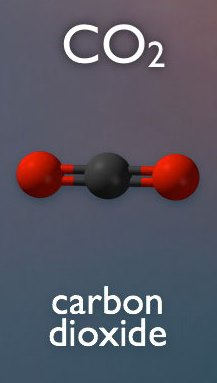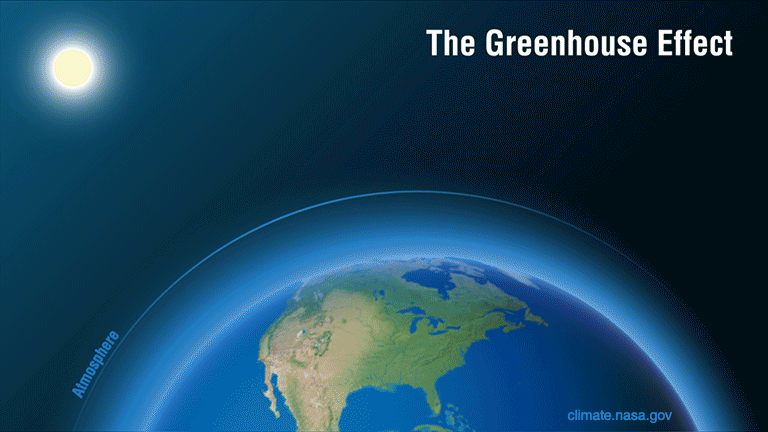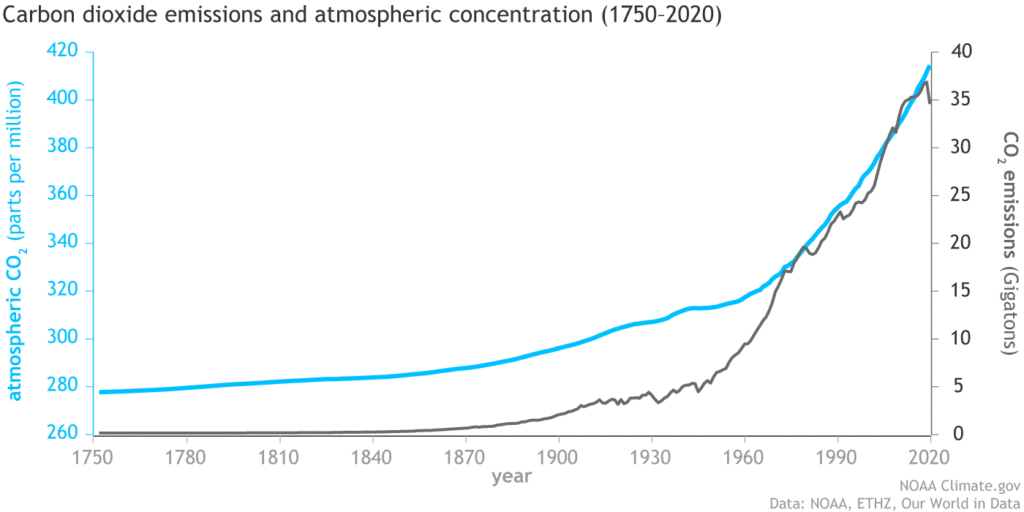Just What is Carbon Dioxide and How Does it Cause Climate Change?
Many people are wondering about it.
Maybe you didn’t take chemistry in high school. And you may not have paid enough attention in biology class to remember. Or science just may not be your strong suit.
But now there is so much talk about climate change, global warming, carbon dioxide, carbon, and dire predictions for our future.
You may be wondering if this is all true. And if you have children, what kind of future they may have if it is.
Understanding what carbon dioxide is and what it does in the atmosphere is fundamental to being able to understand the talk about climate change.
It’s a simple molecule. Though it’s present in very small quantities, it plays a huge role in the atmosphere—and it makes life possible.
I’d like to explain what it is and what it does for us…and why we should all care about it.
Shall I?
What is carbon dioxide, exactly?

It’s a simple little molecule made of one carbon atom and two oxygen atoms. That’s why it’s called carbon dioxide; the di- refers to two oxygens held in a molecule. CO2 is the scientific shorthand for it.
CO2 is an odorless, colorless gas. There isn’t that much in the atmosphere, but it has had a tremendous impact on the processes that shape the earth and the life on it. It’s made the earth suitable for life.
Without CO2 there would be no life.
All the plants on earth inhale CO2 and use the carbon to build the tissues in their bodies…trees, ferns, flowers, herbs, grains, and even planktons in the sea. Plants exhale oxygen atoms from the CO2 molecule. All animals on earth breathe in oxygen to keep their bodies alive. They use it to burn energy they get from food and exhale carbon dioxide. It’s a perfect system!
What does CO2 do to the atmosphere?
There isn’t really that much carbon dioxide in the atmosphere—but what there is packs a powerful punch.
The atmosphere has 5 main layers. The bottom layer goes from the earth’s surface up to about 6 miles high. It’s called the troposphere and it’s the only place where there’s enough air pressure and a temperature range for life to occur. The other layers of the atmosphere are too hot, too cold, or don’t have the air pressure for anything to live.
The troposphere is made of about 78% nitrogen and 21% oxygen. Next is argon at 0.04% then carbon dioxide is at, well, currently at ….0.0413.3%…and rising. An easier way to say this is 413 parts per million, or 413 ppm.* But over the past 800,00 years it was never above 0.03%
Sounds insignificant, doesn’t it?
But carbon dioxide isn’t like most gases in the troposphere. It can’t absorb sunlight. But when sunlight hits the earth some is absorbed into the earth, like when rocks get hot in the summer. Some light is reflected back to space and some of it loses some energy and becomes infrared light, or a hot light.
Carbon dioxide absorbs the infrared light and holds it in the atmosphere, instead of it radiating back out to space. This warms the air to an inhabitable range.
This is why carbon dioxide is called a greenhouse gas. It creates a greenhouse effect in the atmosphere. In the right amounts it’s just enough to make life on earth possible. But too much and it gets too hot. Too little and we have ice ages and frozen oceans.

Where does it come from?
When burned, fossil fuels release CO2 to the atmosphere. In the 1900’s CO2 emissions from fossil fuels began to rise quickly, and then more rapidly in the last decade. This coincides with the expansion of the industrial age and our dependence on fossil fuels.
There are other greenhouse gases: water vapor, methane (a very strong one), and nitrous oxide. But unlike the others, carbon dioxide stays in the air for hundreds to thousands of years.
Many other factors have been involved with changes in atmospheric temperatures over the millennia, like volcanoes, wobbles in the earth’s axis, and some solar cooling. But what scientists have found is that the level of atmospheric CO2 has fluctuated in direct proportion to the temperatures on the earth’s surface over the past 400 million years.
How does CO2 affect the climate?
It took the earth 4.5 billion years to evolve an atmosphere with the temperature ranges that support life—with just the right amount of CO2.
Consistent seasonal temperature fluctuations have given us predictable weather patterns, temperature ranges we can live in, and ecosystems that provide us with food sources. These predictable weather patterns are what we call climate.
Changes in temperatures in the atmosphere change weather patterns. When atmospheric temperatures rise, so do oceanic temperatures. These higher than normal temperatures on land and seas change patterns. New and less predictable weather patterns create different climates, climates that are less stable and less able to support the ecosystems of any one place, and climates with weather patterns that are not necessarily compatible with our normal ways of life: like our agricultural systems or our infrastructures.
According to the EPA’s website under “Weather and Climate”:
“Rising global average temperature is associated with widespread changes in weather patterns. Scientific studies indicate that extreme weather events such as heat waves and large storms are likely to become more frequent or more intense with human-induced climate change.”
It took a long time for the atmosphere to have just the right level of CO2, one that allowed humanity to build its societies and its agriculture.
Seemingly small changes in CO2 in the atmosphere have a big impact on climate. Let’s look at the numbers both past and present.
What have CO2 levels been in the past?
From 400 million years to 1 million years ago the amount of carbon dioxide in the atmosphere fluctuated wildly with levels ranging from above 2000 ppm down to around 300 ppm. Much of the CO2 increase came from volcanic activity. And much of the CO2 was absorbed by the oceans.
In the period from 1 million years to ten thousand years ago the CO2 level fluctuated much less widely. Between slightly under 200 and slightly above 300 ppm, the earth oscillated between ice ages and very warm periods.

Ten thousand years ago the CO2 level is settled in to a steady level at around 280 ppm. This is when ice from the last ice ages melted but left behind the polar ice caps and glaciers in high mountains. The steady climates and weather patterns fostered the development of the equatorial tropical rainforests and everything in between: the ecosystems that we now know that have provided us with a livable climate, food to eat, and wood for fuel and building.
Plus, it rendered a steady climate so we know what and when to plant to assure our food supply.
What does too much CO2 do to the earth?
We are now at 413 ppm, the level of CO2 that the earth hasn’t seen since 300 million years ago in the Oligocene period. Average temperatures of that era were only 4-6 ͦ Celsius above what they are now. That may not sound like much, but4-6 ͦ C is 32 – 43 ͦ F. (That means a mild summer day at 80 ͦ F would be up to 123 ͦ F). To maintain the temperatures close to normal to our current earth, it has been thought that we can tolerate only a 2 ͦ C increase.
But the CO2 level keeps rising. You can see from the graph that from 1960 on, the level has increased abruptly, with no sign of slowing down.
It’s been shown that there’s about a 50 yr. lag between a higher level of CO2 in the atmosphere and the full effects of that level. That means we will experience changes over the next 50 years IF CO2 levels stay the same. But they keep rising.
These changes include the melting of the polar ice caps and glaciers. Sea levels rising because of this newly released water, making coastal communities and islands unlivable. More severe, destructive, and less predictable storms. Droughts in some areas and excessive rains in others. Bigger wildfires and floods. Killing heat waves. Haven’t we been seeing this already?
And even more CO2 and methane will be released from sources where they have been locked up by the stable temperature range we have been living with. Sources like the oceans and permafrost in the arctic…exacerbating the problem even further.
What do we do?
The CO2 level has been rising increasingly fast. Remember that CO2 persists in the atmosphere for hundreds to thousands of years. It’s taken up by natural processes like plants and oceans. But we’re far beyond what can be absorbed.
Unless, of course we can develop technologies that will help—which people are working on, but no promises yet.
But there are things we can do to help cap the CO2 we’re putting into the atmosphere and to reduce it. One of our most promising and all around beneficial answers lies in….the soil. How we farm and garden can have a surprisingly huge impact on the problem. (See Two Powerful Ways Soil Soaks up Carbon Dioxide.)
And of course the underlying solution is to simply care. Caring, knowing more, and understanding our situation at hand helps each and every one of us make better decisions and guide our everyday actions for the better.
Now you are able to understand carbon dioxide and the climate change problem at least a little bit more. The talk about carbon refers to carbon dioxide. And you now have a better understanding of what CO2 does in the atmosphere.
Let’s create a better future
The troposphere is quite possibly the only place in the entire universe that supports life. Isn’t it entirely in our best interests to take care of this part of our home?
This is truly the most momentous time on our earth. All of humanity is needed to turn our problem around.
Try starting with two things. Find ways to reduce your own fossil fuel consumption. And treat your garden soil well. Read my article Two Powerful Ways Soil Soaks Up Carbon Dioxide for information.
Our children and grandchildren are the ones who gain the most.
* This number rises every single day. See the Daily CO2 report to monitor it yourself.
Related Reading:
What are Carbon Emissions?
Global Warming or Climate Change–Which is the Better Term?
Two Powerful Ways Soil Soaks Up Carbon Dioxide
Main References:
EPA Climate Change Indictors
NOAA Climate Change: Atmospheric Carbon Dioxide
A Graphical History of Carbon Dioxide Levels Over Time

